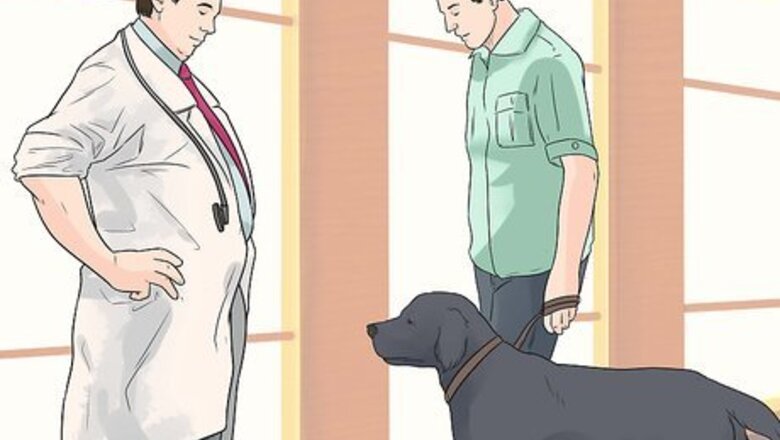
views
Determining if a Dog Needs an Enema
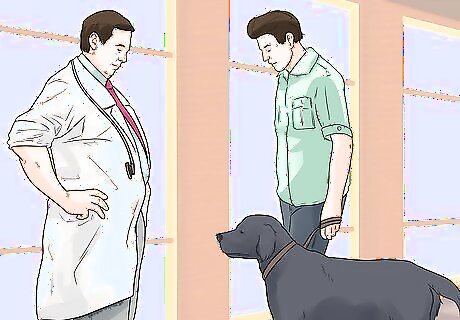
Take your dog to see a veterinarian. Before you decide to give your dog an enema, you should take your dog to see a veterinarian. If you suspect that your dog is constipated because you have noticed him straining or because you have noticed that he is not pooping at all, then make an appointment to have your dog examined. Your dog may have an obstruction or the problem may be related to an underlying cause that requires treatment. Performing an enema incorrectly can be harmful to your pet. Do not attempt to perform an enema on your dog without first consulting your veterinarian and getting advice.
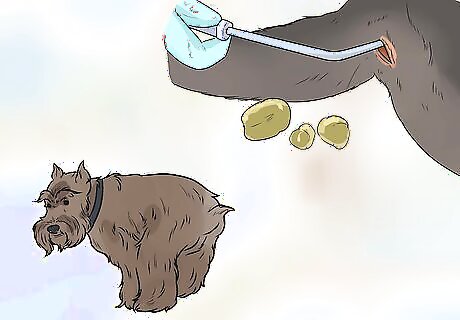
Be aware that enemas should only be used to help with constipation. Constipation is the buildup of feces in the lowest part of the bowel. This can occur because of a lack of fiber in the diet, which tends to produce a hard, dry stool that is difficult to pass. Other less common causes of constipation include: Not getting enough exercise. If your dog does not get much exercise, then he may become constipated. Dehydration. If your dog has not been drinking enough water, then he may become constipated. A blockage. If your dog is eating well, exercising, and getting enough water but still not producing any stool, then a blockage may be to blame. A change in the anatomy of the pelvis, such as after being hit by a car. This may cause the pelvis to become narrower and that may make it hard for the dog to pass feces. Arthritis pain in the hips. This may cause a dog to avoid defecating as much as possible rather than deal with the pain and discomfort. This causes the feces to dry out, which makes it even more difficult to pass.
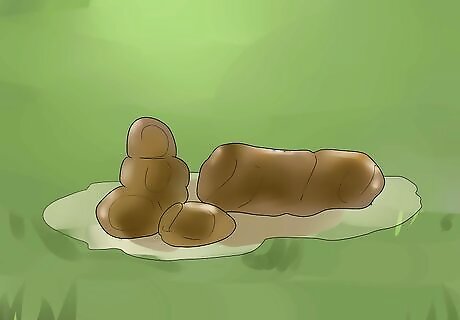
Monitor your dog’s bowel movements. Your dog’s bowel habits and bowel movements can help you to confirm whether or not he is constipated. If you think that your dog may be constipated, then observe him when he goes to do his business and check the yard after he has gone as well. Things to watch for include: Producing hard, dry, and/or small stools. If his stools are hard, small, or if he is not pooping at all, then he may be constipated. Not pooping for several days. If he is eating well but does not poop for several days, then he is probably constipated. Straining when trying to go. If he then starts straining and nothing comes out, then he is likely to be constipated. Crying when trying to defecate. If your dog cries when he tries to go to the bathroom, then you should take him to see a veterinarian right away.
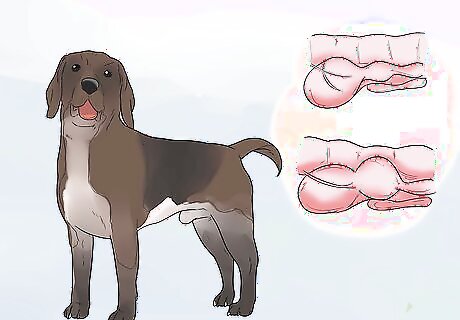
Consider medical conditions that may put your dog at risk of constipation. Certain medical conditions can make it difficult to pass feces. In the male dog, an enlarged prostate gland is a common problem. The prostate sits below the rectum and pushes upwards as it grows bigger. Like putting your foot on a hose, an enlarged prostate can make passing feces difficult.
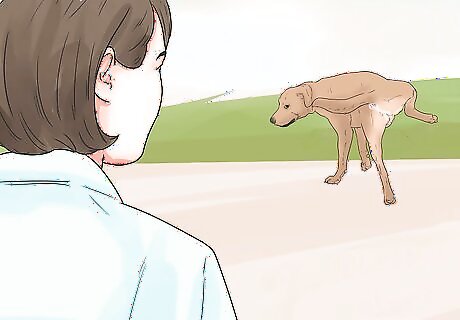
Make sure the problem is not trouble urinating. Difficulty urinating can sometimes look like constipation, especially in female dogs. A dog that often strains when trying to urinate should be taken to a vet as soon as possible, especially if that dog is not passing any urine.
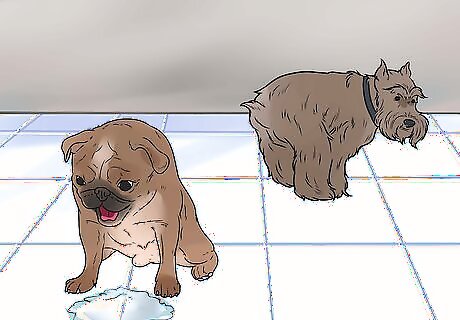
Rule out diarrhea. Diarrhea can be mistaken for constipation because of the behaviors associated with it. Diarrhea may cause a dog to squat often due to a feeling of urgency. That is why it is so important to check your dog’s bowel movements and rule out the possibility that he has diarrhea. If your dog passes liquid stools, then it is unlikely he is constipated and an enema is not necessary or advised.
Preparing to Give an Enema

Choose an area that will be easy to clean. Giving a dog an enema is extremely messy, so choose a place that will be easy to clean and where it will not be a problem if the enema liquid splatters. It is also important to choose an area that is away from food and food preparation areas. Some good options include: An outdoor yard or cement area that you can hose down afterwards A garage with lots of newspaper laid out on the floor

Wear protective clothing. Consider purchasing a disposable plastic apron to protect your clothing from enema liquid splatters. Wear waterproof footwear that you can wash afterwards, such as Wellington boots. Disposable latex or rubber gloves are also essential to protect your hands. After giving an enema, dispose of all soiled protective clothing and wash your hands well.
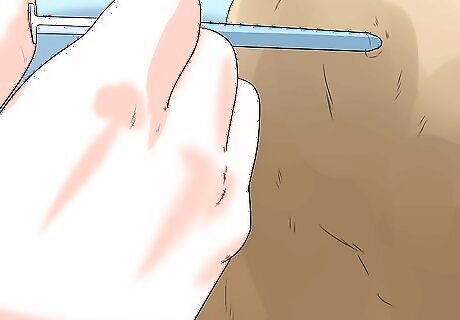
Choose a micro-enema is your dog is suffering from mild constipation. If your dog is mildly constipated, then a micro-enema is appropriate. Your dog may be only mildly constipated if he has just started straining and hasn't missed a bowel movement. Micro-enemas are commercial enemas designed for human use. You can purchase these enemas from a pharmacy. A typical commercial enema is Micralax. Micro-enemas contain a small volume of lubricant which is delivered into the rectum to gently lubricate the feces. These enemas have a gentle (rather than explosive) effect and when used in the early stages of constipation, these types of enemas should help your pet to pass feces normally.
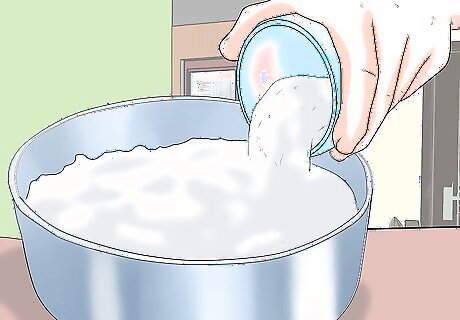
Use warm water if your dog needs a full enema. For a full enema, a larger volume of liquid will need to be introduced. The liquid may be warm water or warm water with a small amount of liquid paraffin added. Avoid using pure liquid paraffin because it can lead to electrolyte imbalances in the blood.
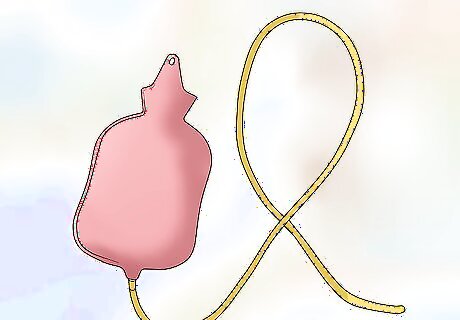
Gather your equipment and enema fluid. The liquid can be introduced into the bowel via an enema pump (which veterinarians commonly use, or a syringe with rubber tubing attached (home enema). It is possible to purchase enema kits from a pharmacy or the internet. The general principle is the same regardless of the exact method of delivery, and this is a reservoir of liquid (bulb, syringe, or pump) that is passed into the rectum via a soft tube. Choose equipment that is appropriate for the size of your dog. A large breed dog may require an enema bag (large capacity) while a toy dog will do just fine with a 2.5 milliliters (0.08 fl oz) syringe. If you are not sure, then ask your veterinarian for a recommendation. Determine how much fluid you should administer. When giving a full enema, the recommended guideline for how much fluid to pump into the rectum is 10-20 ml/kg. Therefore, for a 30 kg Labrador retriever you would administer between 300–600 milliliters (10.1–20.3 fl oz) of fluid. However, it is difficult to instill too much liquid as it will just reflux back out of the rectum. Make sure that you have plenty of extra enema fluid on hand. If your dog fails to pass feces after an enema, then you would need to repeat the process in 1 - 2 hours.

Ask someone to assist you. It is helpful to have an assistant who can hold your dog still and keep your dog’s tail out of the way. This will leave both of your hands free to administer the enema. Your assistant can also comfort the dog by petting him and talk to him. Although, enemas are not painful, having an enema is not comfortable and it may frighten your dog.
Giving Your Dog an Enema
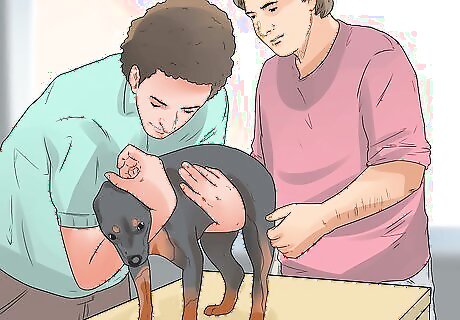
Position your dog. Bring your dog to the chosen spot, making sure the floor is protected with newspaper. Have your assistant hold the dog in a standing position and elevate the tail when you are ready to administer the enema. Stand behind the dog so you have a clear view of his rear end. If your dog has long fur or feathering around the rear end, then consider clipping away the long fur to reduce fecal soiling when the dog does go.
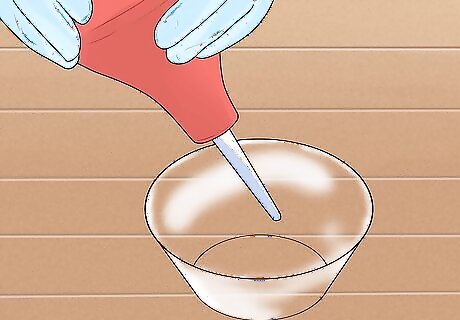
Fill the enema bulb. Other types of enema equipment may use a pump or syringe that you will need to fill. Too fill the bulb, pump, or syringe, submerge the end of the tubing into the enema liquid. Then, compress the bulb to expel all of the air. Next, release the bulb so that the negative pressure pulls in liquid. Make sure that the water is not too hot by testing it on the inside of your wrist. If the water is too hot, then cool it down by adding a little cold water. If you are using a syringe, attach the tubing to the hub of the syringe and suck back on the plunger in order to fill the syringe.
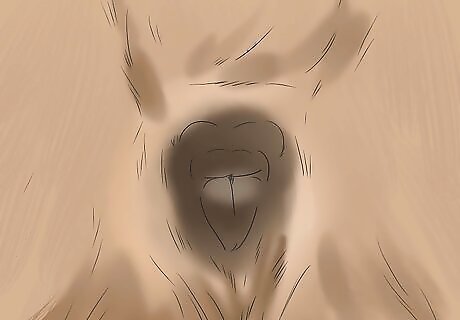
Identify the anus. The anus is the hole through which the dog passes feces. This is easy to identify in the male because it is the only hole. In the female dog the anus is immediately below the tail whilst the vulva is closer to the ground between her back legs.
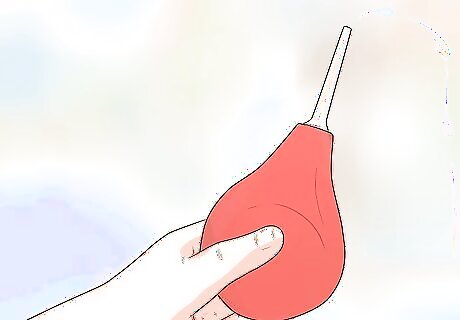
Prime the enema pump. Wearing your protective clothing and gloves, squirt a small volume of liquid out of the end of the tubing to lubricate it or apply some petroleum jelly to the end. Then, take the end of the tubing and gently insert it into your dog’s rectum. Next, apply a bit of gentle pressure at the central part of the anus. It may also help to apply a gentle twisting movement to the tubing as you advance it.
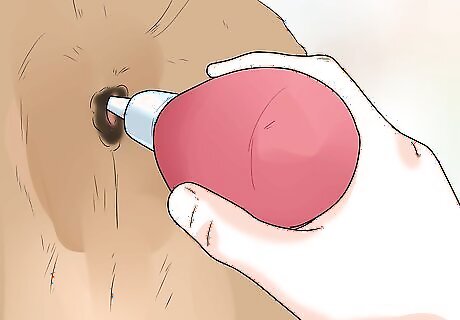
Insert the tubing in a straight line. The rectum lies parallel to the backbone. Aim to direct the tubing forward in a straight line parallel to the spine in order to follow the path of the rectum. Never apply pressure or force. If the tube refuses to advance, leave it where it is and try squirting in some liquid as it might be the tip is jammed against the fecal buildup. Push the tubing about one to two inches into the anus.
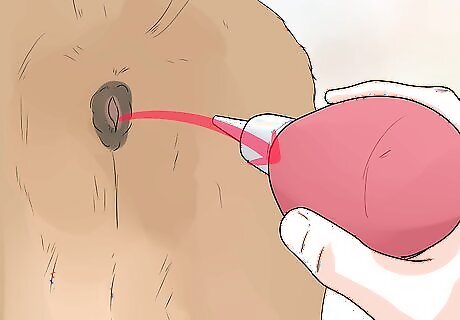
Administer the enema solution. Once tubing is far enough into the anus, then slowly compress the syringe or squeeze the bulb in order to administer the enema. Go slow to ensure that your dog will not be uncomfortable and to prevent injury to the dog’s bowel wall. Once the full volume has been given, slowly remove the enema tubing.
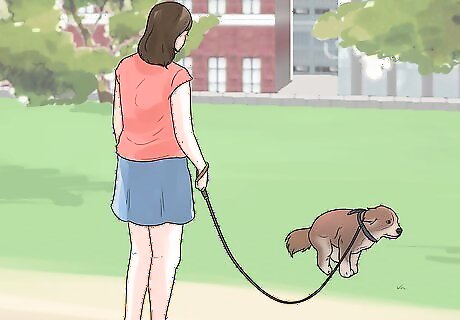
Take your dog to use the bathroom. Take your dog to his usual potty spot and encourage him to go potty. It may help to take your dog for a nice slow, gentle walk to help the fluid mix with the feces and start the softening process. If your dog does not pass feces on the first attempt, repeat the enema process 1 - 2 hours later. Remember to give your dog plenty of opportunities to toilet in between enemas. When he is ready to go, he will need to go right away. Never get angry at a dog that has had an enema and loses control. This is not his fault. To prevent your dog from having an accident on your carpet or furniture, you may want to keep him outside until he has gone.















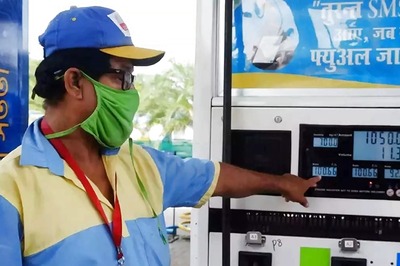



Comments
0 comment